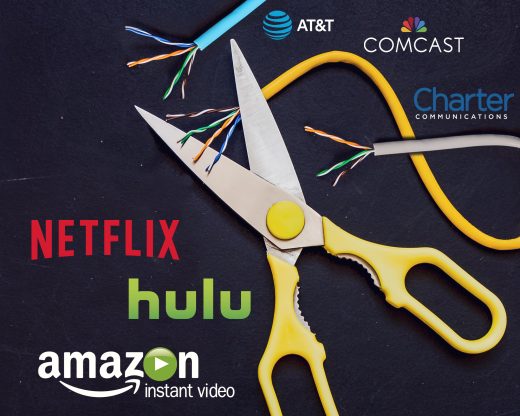
Think about your favorite shows or shows that you’ve watched recently. What platform did you watch them on? Netflix? HBO Max? Hulu? Or, did you watch them on cable television channels like ABC, FOX, TNT or AMC? Chances are, you used one of the various streaming services available.
Why do I say this? Cable television is being left in the past and streaming services are taking over in the future. As of September 2022, only 65% of adults still pay for cable and 82% of US adults claim that streaming shows provide more entertaining shows than cable does. Streaming services now provide a wider variety of entertainment compared to cable, cater better to the busy schedules of today’s younger populations and are also producing better quality television due to higher budgets.
Viewership on streaming services has continuously been ticking upwards. In August 2022, streaming services finally beat out cable television for most minutes viewed. According to Spectrum News, audiences watched an average of 190.9 billion minutes of streaming per week, a 22.6% increase from August 2021. Broadcast television — a subsection of cable that includes ABC, FOX, NBC and other news channels — had been surpassed by streaming services in the past, but cable as a whole had never been surpassed by streaming. Cultural phenomena on streaming services including “Stranger Things,” “The Bear,” “Love Island” and “House of the Dragon” have been partially responsible for this record-breaking statistic.
Everything that is on cable can essentially be found on a streaming service in one way or another. In August, a deal regarding the broadcasting of college football was struck between CBS, FOX and NBC, requiring that some of the games must be streamed on the NBC-owned Peacock and the CBS Sports app. Apple TV+ made deals with both the MLB and the MLS to stream games. Amazon Prime Video is now streaming all Thursday Night Football games. The NFL created NFL+ this year, allowing subscribers to watch all games from their cell phones and tablets for $5.99 per month.
Sports was one of the few advantages that broadcast television had over streaming services, but now both have options to watch official sports leagues online. Deals with these other streaming providers give even more ways for people to watch. Even cable networks have either made their own streaming services, like Paramount+ and Peacock or have sold the rights to some of their most popular shows to streaming giants. All of these services offer commercial-free options, which allows for more convenient viewing compared to On Demand or DVR.
Streaming services are also just much easier for us to use in our day and age. For many of those who have entered the workforce in recent years, the nine-to-five work schedule is almost nonexistent. 26% of millennials have two or more jobs and 73% of millennials with a job work more than 40 hours a week. The routine of coming home, making dinner and settling in to watch primetime television at 8 p.m. is no longer an option for the upcoming generations. The amount of people who prefer staying in on the weekends has also increased due to the rise in people working more than 40 hours a week, which has been proven to have contributed to an increase in streaming on the weekends.
The COVID-19 pandemic has also massively impacted the way we consume media. Many streaming services decreased prices in order to further appeal to viewers during the pandemic, as streaming services allowed for binging in a time where many could not leave their homes. An increase in companies allowing their employees to work at home also contributed to more streaming, as cable networks usually only air new episodes at night, whereas viewers can binge TV episodes any time using streaming services.
Streaming services allow us to watch shows whenever we want with no DVRs required and no schedule you need to check. Sure, some streaming services like Hulu, Disney+ and Prime Video release some of their original content as weekly episodes, but you don’t need to watch it at the time it comes out, check On Demand or pre-record the episode like you would have to do on cable. In many cases, there is a limit on how long you can have an episode pre-recorded, and many episodes released On Demand are only available for a short period of time before they disappear.
The decidedly higher budgets of streaming service shows also allows for higher viewership through advertising. According to Collider, out of the 10 most expensive TV shows, nine belong to a streaming service, while only one belongs to a cable network (HBO). Advertising makes up a lot of these budgets and as of January 2022, the average television ad costs $104,700.
Most social media sites follow a method called PPC, or “pay-per-click.” PPC means that the cost of an advertisement increases per view, which is added on to a base rate of around $2,000-$4,000. When you compare the most expensive show in history (Amazon’s “Rings of Power”), which comes in at a whopping $58 million per episode (2022 USD), to the lone cable show on the list (HBO’s “The Pacific”) at $20 million (2022 USD) per episode, it’s quite clear how much more Amazon can invest into advertising than an HBO cable show. “The Pacific” also premiered in 2010 at a time where cable channels like HBO ruled the television industry.
Critical acclaim has also been directed more towards streaming services than cable television in the past few years, and these numbers are continuing to increase. At the 2022 Emmy Awards, cable television channels only won three televised awards, compared to 11 wins for HBO, which has its shows streaming jointly on HBO Max, and 11 wins for other streaming services.
The number of award nominations for streaming services has been steadily increasing over the past few years, from 322 overall nominations in 2019 to 418 overall nominations in 2022. The higher budgets given to these streaming shows is once again coming into play here; better visual effects, costumes, production sets and even the amount of time that a production has to film all thrive with a bigger budget, which these streaming services provide to their shows.
We should expect to continue to see a rise in the popularity of streaming services and a continuing decline in cable television. Streaming services provide more entertainment and flexibility to their viewers with a big budget to back them up. While cable may have served us better in the past, it’s time to usher in a new age of entertainment as we advance technologically.












